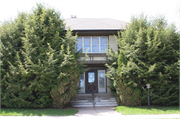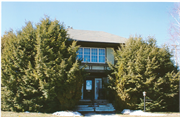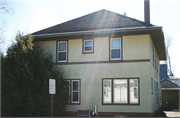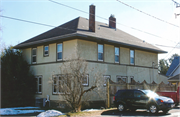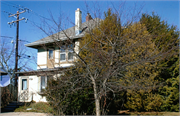Property Record
702 S 1ST AVE
Architecture and History Inventory
| Historic Name: | Anton & Anna Heinzen House |
|---|---|
| Other Name: | |
| Contributing: | |
| Reference Number: | 50467 |
| Location (Address): | 702 S 1ST AVE |
|---|---|
| County: | Marathon |
| City: | Wausau |
| Township/Village: | |
| Unincorporated Community: | |
| Town: | |
| Range: | |
| Direction: | |
| Section: | |
| Quarter Section: | |
| Quarter/Quarter Section: |
| Year Built: | 1918 |
|---|---|
| Additions: | 1983 |
| Survey Date: | 198320162018 |
| Historic Use: | house |
| Architectural Style: | Prairie School |
| Structural System: | |
| Wall Material: | Stucco |
| Architect: | |
| Other Buildings On Site: | Y |
| Demolished?: | No |
| Demolished Date: |
| National/State Register Listing Name: | Not listed |
|---|---|
| National Register Listing Date: | |
| State Register Listing Date: |
| Additional Information: | A 'site file' exists for this property. It contains additional information such as correspondence, newspaper clippings, or historical information. It is a public record and may be viewed in person at the Wisconsin Historical Society, State Historic Preservation Office. Belt course; central pavilion. Porch on south side renovated into a kitchen in 1983. 2017- "The Anton & Anna Heinzen House is located at the southwest corner of the intersection of S. 1st Avenue and Porter Street in the City of Wausau, Marathon County. Situated on the city's west side, the house is located at the top of a bluff that runs along the west bank of the Wisconsin River. To the north, west and south of the house are single-family and apartment residences that date from the 1910s to the 1940s, many of which exhibit reduced integrity due to the application of modern siding and fenestration. A tall wooden fence on an adjacent parcel runs near the subject lot's west property line. Vehicular access to the property is via driveways from both S. 1st Avenue and Porter Street. The house, which is significantly obscured from the street by heavy foliage, is approximately 22 feet from the current back-of-curb of S. 1st Avenue and approximately 27 feet from the current back-of-curb of Porter Street. The property consists of a house and a garage, both of which are considered to be contributing. House (Contributing, 1918): Rising two stories and topped with a hipped roof, this Prairie School-style house rests on a brick foundation and is covered with stucco embellished with horizontal wooden bands that run along the watertable, below the second-floor windows and underneath the aluminum-sheathed eaves. A small, one-story block extends to the south. Fenestration is original and consists mostly of double-hung sash with upper sash featuring rectilinear pattern glazing. Casement windows and picture windows with transoms are also present. These windows are protected by a combination of original and metal combination storms. The main facade faces east and includes a second-story projecting block at the center that extends over the main entrance. The entrance is flanked by stucco-clad pilaster piers embellished with small wooden blocks set in pairs. Rectilinear-patterned sidelights protected by original wooden storms (with the same window pattern) flank the doorway. A concrete stoop with short brick walls topped with round concrete planters provides access to the entrance. Meanwhile, a bank of four casement windows protected by twelve-light wooden storms is situated above the entrance; the arrangement includes a heavy timber sill underscored by paired sets of carved wood brackets. Foliage prevents photography of the remainder of the main facade; however, brief visual confirmation from the stoop confirms the facade is largely unchanged from its 1978 WHPD survey photo. At each side of the entrance is a picture window flanked by double-hung sash. Paired sets of double-hung sash are oriented above on the second floor. The north facade on the first level features two picture windows topped with a transom and flanked by double-hung sash, all of which are protected by original wooden storms. Both the transom and top sash display a rectilinear pattern. Meanwhile, the second level consists of two doublehung sash that flank a smaller example. These windows feature a rectilinear patterned top sash and are protected by metal combination storms. Moving from left to right on the west (rear) facade are a pair of high-sitting fixed windows, a paired set of double-hung sash followed closely by another fixed window. Three double-hung sash pierce the second level. A chimney through the west roof slope is positioned to suggest a fireplace between the first two fixed windows on the first floor. A one-story, shed-roof block is attached to the south elevation at the southwest corner. The block's south side has a doorway accessed by a set of cast-concrete steps and a modern tripartite bay window unit. Meanwhile, the second floor is comprised of a balcony door, a paired set of doublehung sash and a concrete block wall chimney. The exterior integrity is very good. The house features original stucco sheathing and fenestration. The most notable alteration consists of converting into a kitchen (1983) the attached porch with balcony on the south fagade and sheathing the eaves with aluminum. Regarding the interior, the first floor includes an open wooden stairway at the entrance and a living room with tile fireplace flanked by built-in cabinets. One bedroom is located on the first floor and three additional are located upstairs. Interior details include hardwood floors, plaster walls, wooden paneling, built-in cabinetry and quarter-sawn oak trim. Garage (Contributing, 1918): This one-car, hipped-roof garage is located at the parcel's southwest corner and is accessed by a driveway that opens onto Porter Street. It is sheathed with a combination of stucco and board-and-batten siding. Two nine-light fixed windows pierce the east fac;ade while a modern overhead garage door occupies the entire north elevation." -Anton & Anna Heinzen House", WisDOT#6999-18-13, Prepared by Brian J. Faltinson, (2017). Anton C. Heinzen was born on 13 April 1879 in Sheboygan and married Anna D. Ronk in 1901. He apprenticed as a boilermaker and was part of the group that established Northern Boiler & Structural Iron Works in Appleton. In 1907, the couple moved to Wausau where Anton became the superintendent of Northern Boiler’s newly established Wausau branch. The next year, Anton partnered with his brother John and Fred W. Krause to acquire the branch and establish the Wausau Iron Works with Anton serving as the president and general manager. The company initially concentrated on manufacturing boilers and diversified in 1910 into the business of fabricating and erecting bridges. The company built a large production facility in 1911 and expanded it three times by 1930. The company emerged as a notable bridge builder in the upper Midwest. Significant bridges fabricated by the Wausau Iron Works include the Memorial Bridge in Wausau and the National Register-listed Sturgeon Bay Bascule Bridge. Heinzen partnered with Edward A. Drott Sr. in 1923 to design and manufacture the V-blade Wausau Snow Plow, which was mounted on large tractor. Four years later, the firm introduced a plow that could be mounted on a four-wheel drive truck. Wausau Iron snowplows were distributed nationally by Drott’s Hi Way Service Corporation. Heinzen patented in 1929 and 1930 his methods of attaching a snowplow to both tractors and trucks. Both designs have been cited within other snowplow-related patents, with the most recent in 2016. Heinzen’s pioneering designs made Wausau Iron a leading national manufacturer of snowplows. In 1933, Anton Heinzen sold his share in the company, which also ended its bridge erection and concrete paving concerns. Wausau Iron now concentrated its efforts into building and selling snowplows, warehousing steel and fabricating structural steel, which still included bridge components. John Heinzen turned the company to his son Ray in 1949. As Wausau Iron continued to expand its snowplow business it dropped its bridge fabrication (1951) and steel warehousing ventures (1962). In 1963, its production of 2,000 units made Wausau Iron the world’s largest manufacturer of snowplows and snowloaders. Ed Drott Jr. purchased the Heinzen family’s stock in 1971 and changed the name to LOED Corporation the next year. The company sold its snowplow business in 1981 and closed in 1984. Anton and Anna Heinzen in 1918 built the subject house overlooking the Wisconsin River. Located on the west side of the river and not in the east side neighborhood inhabited by the city’s other industrialists, the subject house is less than a mile from the Wausau Iron Works. Heinzen died in 1940 and Anna sold the house to Samuel Trainor by 1945; Trainor owned the Marathon County Oil Company and remained in the residence until selling it to George H. Dern in 1957. Carroll E. Tilton occupied the house as early as 1965 and sold it to Robert Paustian by 1970. Paustian in 1983 converted the one-story porch block on the south façade into a kitchen. |
|---|---|
| Bibliographic References: | Marathon County Historical Society Biography Collection; City Directories; Building permits. Garage--AHI 233429. |
| Wisconsin Architecture and History Inventory, State Historic Preservation Office, Wisconsin Historical Society, Madison, Wisconsin |

